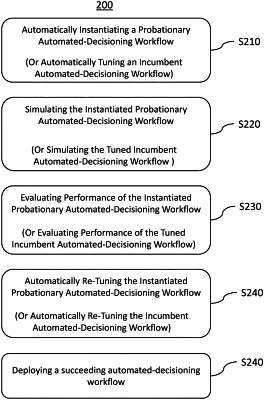| CPC G06Q 20/4016 (2013.01) [G06N 20/00 (2019.01); G06Q 20/389 (2013.01)] | 19 Claims |

|
1. A machine learning-based method for accelerating a generation of automated fraud or abuse detection workflows in a digital threat mitigation platform:
identifying a plurality of distinct digital event features indicative of digital fraud or digital abuse based on an assessment of a digital event data corpus associated with a target subscriber;
automatically deriving a plurality of distinct digital event decisioning criteria based on the plurality of distinct digital event features and the digital event data corpus, wherein automatically deriving the plurality of distinct digital event decisioning criteria includes:
(1) training, via one or more computers, a digital event meta machine learning model comprising a tree classifier using labeled training data samples of the digital event data corpus, wherein the labeled training data samples include a subset of training data samples having one or more of a digital fraud label and a digital abuse label,
wherein the tree classifier, once trained, computes a likelihood that a target digital event is either a digital fraud event or a digital abuse event;
(2) based on the training of the tree classifier, exposing a classification structure including a plurality of digital event classification paths of the tree classifier, wherein the classification structure includes learned conditions and/or criteria applied by the tree classifier for classifying the target digital event to a distinct digital threat class of a plurality of distinct digital threat classes;
(3) extracting, via the one or more computers, from the classification structure of the tree classifier the plurality of distinct digital event decisioning criteria comprising one or more distinct digital event decisioning criteria and/or one or more distinct digital event decisioning conditions for configuring digital fraud detection logic or digital abuse detection logic of a target automated digital fraud or digital abuse detection workflow;
automatically constructing, via the one or more computers, a probationary automated fraud or abuse detection workflow based on the plurality of distinct digital event decisioning criteria, wherein automatically constructing the probationary automated fraud or abuse detection workflow includes:
(a) defining a plurality of distinct automated digital event decisioning routes in the probationary automated fraud or abuse detection workflow, and
(b) setting a distinct route execution condition for each of the plurality of distinct automated digital event decisioning routes based on the plurality of distinct digital event decisioning criteria; and
deploying the probationary automated fraud or abuse detection workflow to a target digital fraud prevention environment of the target subscriber based on identifying efficacy metrics computed for the automated fraud or abuse detection workflow satisfy pre-determined workflow performance criteria.
|